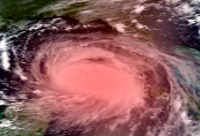

The Biography of a Deadly Storm

Less than two weeks ago hurricane Katrina ripped through a slice of the Southern United States with such devastating force that some experts are claiming that the destruction it left had the appearance of a high-grade nuclear explosion. But how does nature create such a massive storm?
Hurricane Katrina, was the third most severe hurricane to make landfall in the US history. It grazed by New Orleans and made landfall in Biloxi Mississippi in the early morning hours of August 29th. Katrina is believed to have killed thousands of people, and is known to have displaced more than one million — a humanitarian crisis on a scale unseen in the U.S. since the Civil War.
As a tropical storm, Katrina began developing about 175 miles (280 km) east of Nassau, Bahamas. The hurricane strengthened to a Category 1 before making landfall in Florida on August 25th. It then moved southwest across Florida and west into the Gulf of Mexico, where it intensified rapidly to Category 5 storm. In the early morning of August 29th, Katrina made its second landfall near Buras Louisiana as a Category 4 storm featuring 145-mph (235 km/h) winds, and its eyewall passed over the eastern edge of New Orleans as the hurricane made its way to water once again. A few hours later, it made landfall for a third time near the Louisiana/Mississippi border with 125-mph (200 km/h) Category 3 winds. Katrina weakened thereafter, losing "hurricane" status more than 100 miles (160 km) inland, near Laurel Mississippi. It was downgraded to a tropical depression near Clarksville, Tennessee and continued to race northward.
As the hurricane approached landfall near New Orleans, Mayor Ray Nagin placed the city under a mandatory evacuation order. Many residents remained in the city. The vast majority of those who stayed were reported to have been unable to leave because they did not have vehicles, money for gas and other transportation. Also, many residents were unable to travel because they were elderly or infirm. As a result, the Louisiana Superdome was opened as a temporary shelter for those that were to stay in the city, though the city failed to provide any provisions for those seeking shelter. Federal disaster declarations blanketed 90,000 square miles (233,000 km²) of the United States, an area almost as large as the United Kingdom. The hurricane left an estimated five million people without power, and it may be up to two months before all power is restored. Disaster Relief plans are in operation in the affected areas.
Early in the morning of August 30th breaches in three places of the levee system on the Lake Pontchartrain side of New Orleans caused a second and even greater disaster. Heavy flooding covered almost the entire city over a sustained period, forcing the total evacuation of over a million people. Because 80% of the city's area is below Sea level, all water that goes into the city must be directly pumped out--even water from an average rainstorm. Consequently, the city is now uninhabitable until the water is removed.
On September 3rd US Homeland Security Secretary Michael Chertoff described the aftermath of Hurricane Katrina as "probably the worst catastrophe, or set of catastrophes" in the country's history, referring to the Hurricane itself plus the flooding of New Orleans.
Hurricane Katrina may be the deadliest hurricane in the United States since the Galveston hurricane of 1900, which is estimated to have killed 6,000-12,000 people. As of September 1st, more than 20,000 are still reported missing. Local mortuaries have been told to prepare for "up to 40,000 bodies.” New Orleans mayor Ray Nagin stated on August 31st that the death toll of Katrina may be "in the thousands", an estimate also provided through a statement by Louisiana Governor Kathleen Blanco on September 1st. Accurate numbers are not known. Damage was reported in at least 12 states. Hurricane Katrina will be remembered for its vast devastation of the Gulf Coast regions of Louisiana, Mississippi and Alabama.
 Print
Print